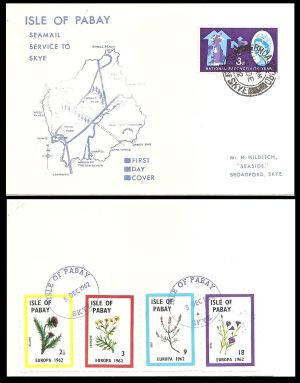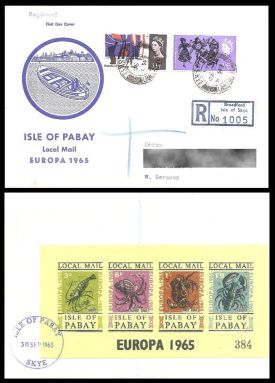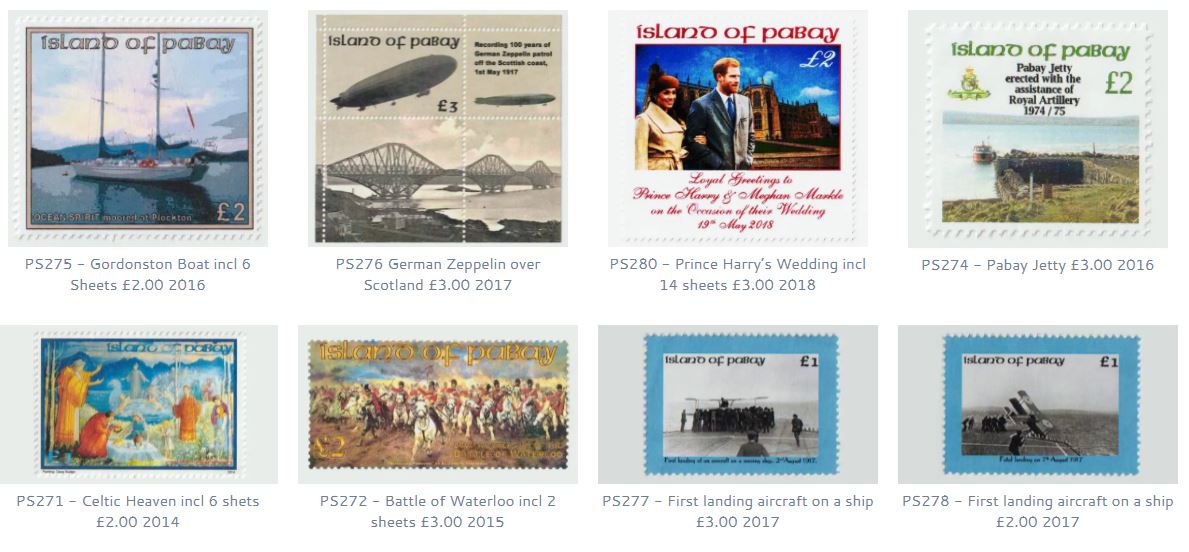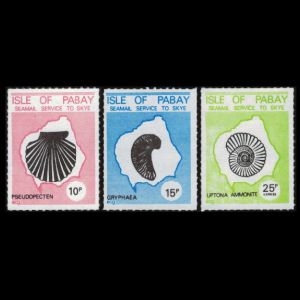the place where Paleontology and Paleoanthropology meets Philately
Pabay Island, Scotland, UK
Fossils on the local carriage labels of Pabay Island
| << previous country | back to index | next country >> |
Contents:
- The island overview
- Philately of Pabay Island
- Local stamps of Pabay Island related to Paleontology
- References
- Acknowledgements
Pabay Island, is a Scottish island just off the coast of Skye.
The name Pabay is derived from an old Norse word meaning “Priest’s Isle”, likely after the ruins of a 13th century chapel found on the island.
The island is about 1.6km acroos with about 5km coast line. The heightest point of the island is about 27 metres above the sea level.
The island consists of fossil-bearing limestone with some micaceous shale. The shales are classified as the Pabay Shale Formation.
It forms a flat plateau with cliffs on the North and East shores. The surrounding low reefs encroach on its shores and double the area at low water.
The island gives its name to a group of Jurassic Sedimentary rocks which are seen across the Inner Hebredian area, the Pabba Shales. The Pabba Shales were later renamed the Pabay Shale Formation.
These were laid down at the bottom of a muddy sea 190 million years ago. Much later (about 60 million years ago) volcanic activity associated with the opening of the Atlantic Ocean led to the intrusion of molten rock along fractures running across the island. The resulting dykes now stand proud as solid sheets resembling well-built masonry and protecting the island from further erosion.
Occupation of the island, in the form of midden material and lithics found in two locations, can be traced back to the prehistoric period, perhaps as far back as the Mesolithic. However, there is little evidence for settlement to bridge the gap between the Mesolithic and the 13th century. From this period onwards, the island is shown on maps and charts, being first named on Dutch cartographer Willem Blaeu's map of 1654.
Today, the owners of the island visit it mostly during summer time and stay in a single farm on the west side of the island. Most of the time there are no humans present on the island. [R1]
Late in 1949 the island was owned by the Whatley family, who remained there until 1969.
In the early 1960s, the family was not able to earn enough income from farming as the prices for some products had dropped.
The Whatleys started to think about new sources of income, such as making ties and socks. The family also tried to encourage tourism to the island, offering accommodation for nature lovers.
The resident population of the island at this time was in the region of 12 persons, rising in the summer to about 20 (the Whatleys family plus some season workers).
To deliver the family-produced goods to the mainland and to develop tourism, Mr. Whatley requested that the British GPO make regular mail and package delivery to Pabay Island.
The British GPO agreed to make one delivery a week to the island from Broadford (Skye Island) and made Mr. Whatley the first postmaster of Pabay Island.
However, Mr. Whatley found this to be inadequate.
 |
 |
| Some examples of letters sent from Pabay island with Pabay's carriage labels on the back side and UK stamps on the front. | |
At the same time, the Whatley family requested the right to produce their own stamps.
The Royal Mail provided permission to do so as the island was without official GPO service. The only stipulations were:
- Pabay carriage labels could not be placed on the front of envelopes (see an example on the right).
- On postcards, the Pabay carriage labels had to be on the left side.
These labels, as well as some envelopes and postcards produced by Whatley's, were offered not only on the Pabay Island, but also in shops and hotels on the Skye Island.
Very soon, Pabay's these products became popular with UK and the foreign stamps collectors, with orders coming in from as far afield as Sweden and Canada.
In order to fill out the demand, the Whatley start to produce big amount of labels.
It was not long before some 25,000 Pabay carriage labels were being sold each year. Over 200 Pabay labels were issued until 1969, most of them on the common, popular topics, totally unrelated to Pabay Island.
Such a large number of issues from a tiny, almost un-inhabited island, made these labels less desirable for collectors – who started to treat them as Cinderellas.
In 1971 the island gained new owners, Anne and Edward Gerrard.
The new owner decided that any future carriage labels issues will focus on local themes and events and will be produced in limited number of issues a year. The first Pabay's new labels of the Gerrard family were issued in August 1972.
However, since 1999 the number of new Pabay issues has again increased. New issues have the mix of topics: some are relevant to the island's heritage and wildlife, others are common: " Battle of Waterloo" (2015), "German Zeppelin over Scotland" (2017), " Prince Harry’s Wedding" (2108), etc. [R2]

Even though some labels of Pabay were used for the "legitimate" mail carriage service, they've never been considered actual stamps.
These labels are not recognized by UPU, not listed by major stamp catalogs and cannot be used at the serious philatelic shows under sponsorship
of FIP or any other major philatelic organization.
Local carriage labels of Pabay Island related to Paleontology: fossils
| 1981 "Fossils" [1] | ||
 |
|
|
Notes:
[N1] These labels set shows three fossils discovered on the island: Pseudopecten (10p), Gryphea (15p) and Uptonia Ammonite (25p).
- Pseudopecten: a genus of Lower to Middle Jurassic bivalves that have a shell morphology similar to scallops (Pectinids such as Pecten sp.). They differ from the pectinids in lacking a ctenolium (a row of denticles along the front edge of the byssal notch). [R3]
- Gryphea – is a genus of oysters that range from the Triassic to the middle Paleogene but are most common during the Triassic and Jurassic. They are commonly called devil’s toenails. Their shells consist of two valves – with one large, curled valve and the other a small flat lid. Like modern oysters they lived in large colonies in shallow marine waters. [R4]
- Uptonia is a genus of ammonoid that lived during the Early Jurassic. These ammonoids have simple ribs (ridges) and complex sutures. [R5]
References:
- [R1] Pabay Island: Wikipedia, official website, hebrideanconnections.com,
- [R2] Postal History and Philately of Pabay Island:
pabay.org,
Graham Land Stamps,
stampedout.nl,
Book "Pabay: An Island Odyssey" by Christopher Whatley, published in 2019. ISBN-10: 178027579X, ISBN-13: 978-1780275796 - [R3] Pseudopecten: pectinidae.
- [R4] Gryphea: Wikipedia.
- [R5] Uptonia Ammonite: Wikipedia.
Acknowledgements:
Many thanks to Dr. Peter Voice from Department of Geological and Environmental Sciences, Western Michigan University, for reviewing the draft page and his very valuable comments.
| << previous country | back to index | next country >> |